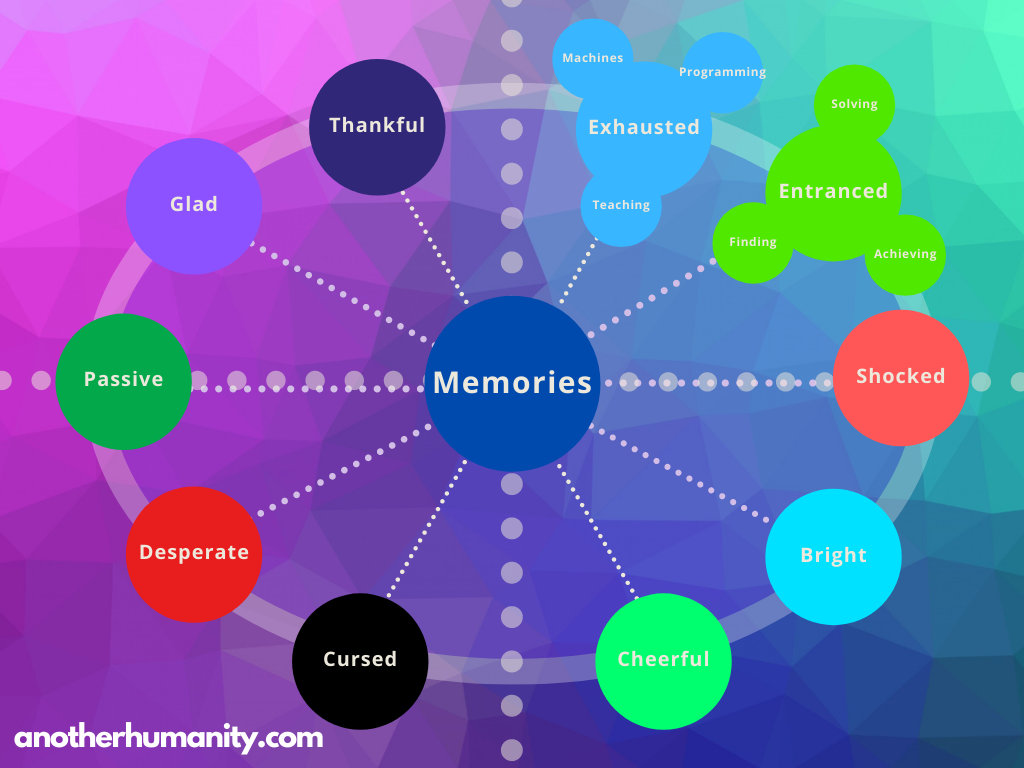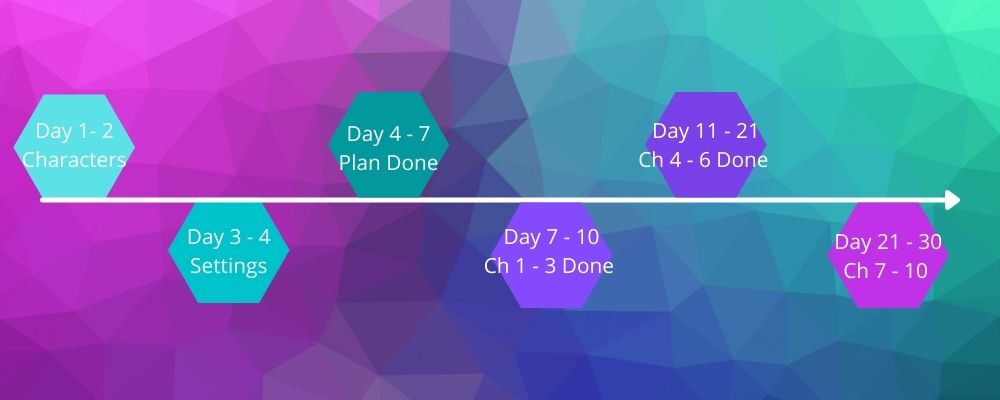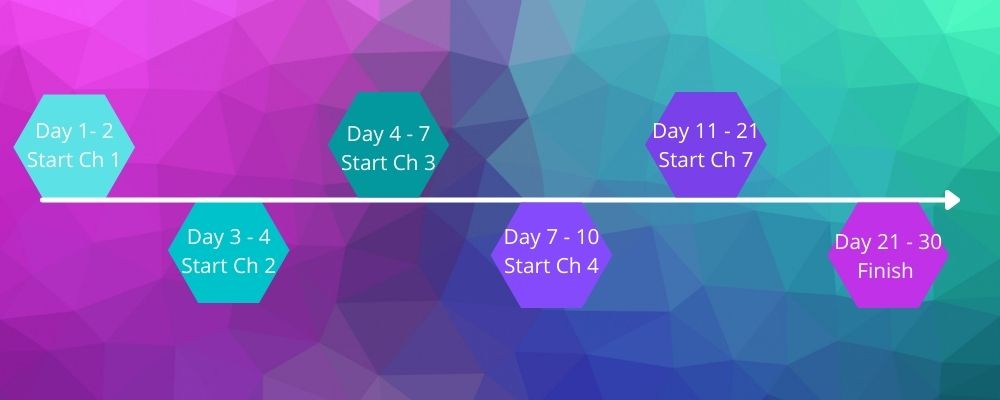
- You want to start a story but have no procedure.
- What about a clean & straightforward one?
- Do you want to write a 100 pages in a month?
- Or 30 pages in a week?
Characters
1st Draft Phase (day 1 – 2)
- Start with 3 Characters.
- Create Relatability 1st.
- And with yourself before anyone else.
- How to love your Characters?
- Protagonist
- Define the character’s Goal through her Name.
- Display her 1 obvious strength in the 1st Chapter.
- Protagonists are generally designed to be likable
- Her strength will often be a desirable character trait
- Display her 1 obvious weakness in the 1st Chapter.
- Protagonists are generally designed to be likable
- Her weakness will be amusing or relatable
- Give her a 1 Quirk/Accessory.
- Most common : Hairstyle, Item, One-Liner
- What’s her Initial Relation to the Antagonist?
- Friend, Ally, Enemy, Foe
- What’s her Initial Relation to the Support?
- Friend, Ally, Enemy, Foe
- Antagonist
- Define the character’s Goal through her Name.
- Display her 1 obvious strength in the 1st Chapter.
- Antagonists are generally designed to be unlikable.
- Her strength will often be considered undesirable.
- Display her 1 obvious weakness in the 1st Chapter.
- Antagonists are generally designed to be unlikable
- Her weakness should still be relatable at this stage
- Give her a 1 Quirk/Accessory.
- Most common : Hairstyle, Item, One-Liner
- What’s her Initial Relation to the Protagonist?
- Friend, Ally, Enemy, Foe
- The Antagonist will often be responsible of the 1st crisis of the Story & create disruption in general
- What’s her Initial Relation to the Support?
- Friend, Ally, Enemy, Foe
- Support
- Define the character’s Goal through her Name.
- Display her 1 obvious strength in the 1st Chapter.
- Display her 1 obvious weakness in the 1st Chapter.
- Give her a 1 Quirk/Accessory.
- Most common : Hairstyle, Item, One-Liner
- What’s her Initial Relation to the Protagonist?
- Friend, Ally, Enemy, Foe
- What’s her Initial Relation to the Antagonist?
- Friend, Ally, Enemy, Foe
- Supports can either ally with Antagonists or Protagonists
Completion Phase (day 14 – 15)
- Add 3 other support Characters with predefined Roles.
- These are 2ndary Characters.
- You may not need them in the end, but keep them as an option.
- These 6 Characters can be used in all of your stories.
- All you have to do afterwards is to switch goals, behavior traits & quirks.
Sponsor
- Define the character’s Goal through her Name.
- What are the Resources allocated by the Sponsor?
- What does she ask for as a Payment?
- What’s her 1 obvious strength?
- What’s her 1 obvious weakness?
- What’s her Quirk/Accessory?
- Most common : Hairstyle, Item, One-Liner
- What’s her Initial Relation to the Protagonist?
- Friend, Ally, Enemy, Foe
- What’s her Initial Relation to the Antagonist?
- Friend, Ally, Enemy, Foe
- What’s her Initial Relation to the Support?
- Friend, Ally, Enemy, Foe
Rival
- Define the character’s Goal through her Name.
- What’s her 1 obvious strength?
- What’s her 1 obvious weakness?
- What’s her Quirk/Accessory?
- Most common : Hairstyle, Item, One-Liner
- What’s her Initial Relation to the Protagonist?
- Friend, Ally, Enemy, Foe
- What’s her Initial Relation to the Antagonist?
- Friend, Ally, Enemy, Foe
- What’s her Initial Relation to the Support?
- Friend, Ally, Enemy, Foe
Arbiter
- Define the character’s Goal through her Name.
- Display conflicts the Arbiter will have to judge.
- Show the Consequences of these judgements.
- 1 obvious strength – Impartial
- 1 obvious weakness – Detached
- What’s her 1 obvious strength?
- What’s her 1 obvious weakness?
- What’s her Quirk/Accessory?
- Most common : Hairstyle, Item, One-Liner
- What’s her Initial Relation to the Protagonist?
- Friend, Ally, Enemy, Foe
- What’s her Initial Relation to the Antagonist?
- Friend, Ally, Enemy, Foe
- What’s her Initial Relation to the Support?
- Friend, Ally, Enemy, Foe
Develop your 3 Original Characters.
- Protagonist
- Did the Character’s goal change?
- Did she abandoned it to pursue a new goal?
- Present 1 strength to hone to reach her goal.
- Unravel 1 hidden weakness that may change the Public point of view on the Character.
- Did her Quirk/Accessory change?
- Most common : Hairstyle, Item, One-Liner
- What’s her New Relation to the Antagonist?
- Friend, Ally, Enemy, Foe
- What’s her New Relation to the Support?
- Friend, Ally, Enemy, Foe
- Antagonist
- Did the Character’s goal change?
- Did she abandoned it to pursue a new goal?
- Present 1 strength to hone to reach her goal.
- Unravel 1 hidden weakness that may change the Public point of view on the Character.
- Did her Quirk/Accessory change?
- Most common : Hairstyle, Item, One-Liner
- What’s her New Relation to the Protagonist?
- Friend, Ally, Enemy, Foe
- What’s her New Relation to the Support?
- Friend, Ally, Enemy, Foe
- Support
- Did the Character’s goal change?
- Did she abandoned it to pursue a new goal?
- Present 1 strength to hone to reach her goal.
- Unravel 1 hidden weakness that may change the Public point of view on the Character.
- Did her Quirk/Accessory change?
- Most common : Hairstyle, Item, One-Liner
- What’s her New Relation to the Protagonist?
- Friend, Ally, Enemy, Foe
- What’s her New Relation to the Antagonist?
- Friend, Ally, Enemy, Foe
Environments
1st Draft Phase (day 3 – 4)
- Start with 1 Environment.
- Whatever the Scale you’ll need to find the same elements in each of them.
- A place to Rest.
- A place to Fight.
- A place to Prepare/Converse.
- If you design a City start with a District.
- If you design a District start with a House.
- If you design a House start with a Room.
- Everything is Scalable Up & Down.
- The Preliminary Phase is there to offer your characters a Place to Start.
- Once you’ve started, the Story will write itself more easily.
- This Place will allow you to display events.
- It will allow your characters to meet each other.
- Every Room, every setting is a place of representation.
- What you need to describe?
- Atmosphere – Climate, Light, Colors.
- People – Quirks, Daily Conversations, Daily Life.
- Organizations – Goal, Hierarchy, Leaders.
- Landscape & Landmarks – Animals, Symbols.
- Keep it at 1-2 sentence for each.
- Develop only if necessary.
Completion Phase (day 15 – 16)
- Create Generic Environments you can reuse.
- 1 City template.
- 1 Town template.
- 1 House template.
- 4 Natural Environments.
- Mountain & Rivers
- Atmosphere
- Fauna & Flora
- Plains & Lakes
- Atmosphere
- Fauna & Flora
- Seas & Islands
- Atmosphere
- Fauna & Flora
- Forests & Ponds/Creeks
- Atmosphere
- Fauna & Flora
- Mountain & Rivers
- Create Specific Landmarks that will frame your Story.
- 1 Tower/Mall.
- People
- Furniture/Objects
- 1 Park.
- People
- Furniture/Objects
- 1 Library/Museum/Cinema.
- People
- Furniture/Objects
- 1 Hotel/Inn.
- People
- Furniture/Objects
- 1 Café/Restaurant/Dinner.
- People
- Furniture/Objects
Story
1st Draft Phase (day 1 – 4)
- Start with the End.
- Imagine up to 10 Different endings.
- What’s Different?
- Every new crucial element added or removed from an outcome changes the ending.
- It can be the acquisition/loss of a Key item/character.
- It can be a change in the Way of obtaining/losing this Object.
- You can also change the Role/Function of the Object.
- Pick your Favorite Ending & Create a Matching Introduction.
- Now you have the 10th & 1st chapters you need to plan chapters 3, 6 & 9.
- Chapters 3, 6 & 9 are Crisis chapters.
- Display critical changes in these chapters.
- Critical Wins: New Ally, new Estate, new Status.
- Critical Losses: Death/Destruction, Betrayal, Madness.
Chapter’s Structure.
- Atmosphere – Colors, Climate, Light.
- People, introduce characters (if any).
- Indicate Character’s evolution
- Display Relationships’ evolutions
- Setting.
- Where are they?
- Why are they here?
- Issue.
- Who/What caused the Issue?
- Why/When did they caused it?
- Outcome
- How is the Issue Solved?
- What is Won?
- What is Lost?
Completion Phase (day 1 – 30)
- Start Writing from the 1st day if you can.
- The sooner you let the story unfold, the more ideas you’ll find.
- The sooner you begin to write the sooner you’ll notice the issues.
- In the early stages you’ll probably have multiple endings, branched scenario, and still be indecise.
- The sooner you begin, the sooner you can choose.
- Each Chapter will take you up to 3 days to write.
- If you write for 30′-40’/day you can write up to 5 pages.
- Each chapter will be 10-15 pages long, for a 100-150 pages book.
- If you write for 60′-90’/day you can write up to 10 pages.
- Each chapter will be 20-30 pages long, for a 200-300 pages book.
- Timeline.
- Chapters 1 to 3 will take you up to 9 days.
- Try to write Chapter 1 in 1 day if you can.
- The faster you finish the 1st chapter, the more motivated you’ll be to write the rest of the book.
- Take 3 days for Chapter 3.
- It is your 1st Crisis chapter
- You may be blocked on the 3rd day when you’ll have to finish it
- Finish it nonetheless
- Chapter 3 is the 1st Barrier to the Completion of your Book
- Chapters 4 to 6 will take you up to 9 days.
- Take up to 4 days for Chapter 6.
- It is most likely the peak tension of your book
- Chapters 7 to 9 will be written much faster than the rest of the book since you have reached peak writing velocity.
- You may still take 3 days to write Chapter 9.
- It is a critical Chapter and the transition to your epilogue.

